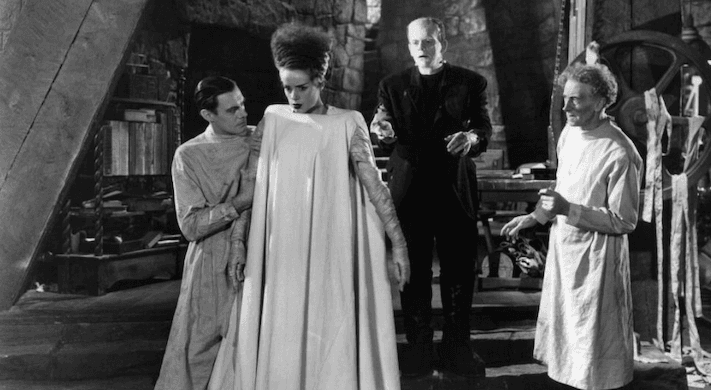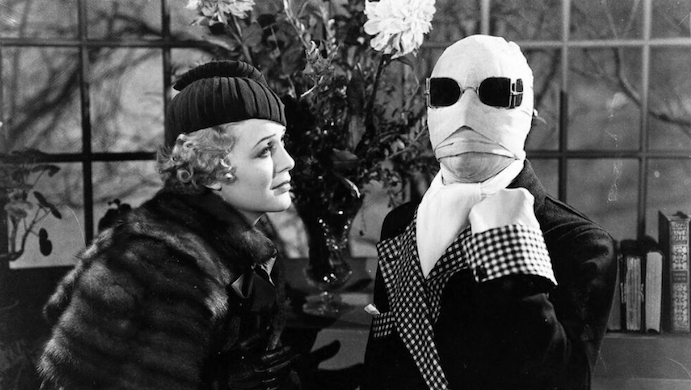The Quad Celebrates Halloween and Some Masters of the Ghostly, the Ghastly, and the Atmospheric
Starting Friday with ‘Frankenstein’ (1931), the Greenwich Village stalwart honors Universal Studios and a British-born director who is responsible for helming four of the five pictures being featured, James Whale.

‘Universal Horror, 1931-35’
Quad Cinema
October 27-31
At this point in time, and to the extent that any sense of cultural memory extends beyond the previous five minutes, the British actor Claude Rains (1889-1967) is likely best known for his role in “Casablanca” (1942) playing Captain Louis Renault, the cynic whose heart of gold arrives better late than never.
The good captain’s response to learning that there’s gambling afoot at the local nightspot — that would, of course, be Rick’s Café Américain — has become part of our lingua franca. Should you be “shocked, shocked” to learn that a conversational commonplace originated in a fusty black-and-white movie — well, my friend, you’ve been gaslighted.
Rains made his American film debut in a role that might have made a lesser actor — or a bigger ego — take umbrage. As the title figure in “The Invisible Man” (1933), we don’t see Rains’s face until the final minute of the picture, the moment in which Dr. Jack Griffin comes to observable resolution on his deathbed. Heralded by a dramatic crescendo of music, the reveal is underwhelming. Dr. Griffin in the flesh is nowhere near as compelling as the Invisible Man on a tear. Scriptwriter R.C. Sherriff provided the unseen Rains with indelibly over-the-top dialogue. Rains responded with palpable gusto.
“The Invisible Man” is part of “Universal Horror, 1931-35,” an abbreviated series of films presented by the Quad Cinema at Greenwich Village. Starting this Friday with “Frankenstein” (1931), the Quad is honoring not only Halloween 2023 and Universal Studios, but a British-born director who is responsible for helming four of the five pictures being featured, James Whale (1889-1957), and a fellow Brit actor, Boris Karloff (1887-1969), who, likewise, is seen in a majority of the films on view.
Not only did Whale helm “The Invisible Man” and “Frankenstein,” but he also was responsible for “The Old Dark House” (1932) and “Bride of Frankenstein” (1935), the latter being a prime example of the rare sequel that improves upon the original.

As for “The Mummy” (1932), Karl Freund was the director of that tale of revenge from beyond the grave and within a tomb. Freund went on to work with Peter Lorre in “Mad Love” (1935) and was later strong-armed by Desi Arnaz to be the cinematographer for “I Love Lucy.” Many of the formatting precedents Freund established for Lucy, Ricky, Fred, and Ethel became standards for the industry.
Freund was also the cinematographer for “Dracula” (1931), the film whose success established Universal Studios as Hollywood’s “house of horrors.” When “Frankenstein” hit big later that year, studio execs who were initially hesitant about making a specialty of things that go bump in the night went full bore into the ghostly, the ghastly, and the atmospheric.
After the one-two punch prompted by Bram Stoker and Mary Shelley, Universal mined H.G. Wells (“The Invisible Man” and “The Island of Doctor Moreau”), Edgar Allan Poe (“Murders in the Rue Morgue” and “The Raven”), Mitteleuropean bogeymen (“The Wolfman”), and the pseudo-Satanism of Aleister Crowley (“The Black Cat”). Few of these adaptations hewed closely to their sources, but all of them created templates that have become part-and-parcel of pop culture DNA. Sine qua non and all that….
Of the films playing at the Quad, “The Mummy”is the ricketiest in terms of story and momentum. The picture benefits mightily from Freund’s cinematography and the gravitas of Karloff’s performance in the title role. As with his take on the Frankenstein monster, Karloff was able to shade the dreaded Imhotep with a pitiable sense of longing, of emotions deeply felt if barely articulated.
His role as a mute butler, Morgan, in “The Old Dark House” isn’t as substantial: He’s basically fifth business to a stellar cast that includes Charles Laughton, Melvyn Douglas, Ernest Thesiger, and Gloria Stuart — who would, some six decades later, star as the aged Rose Dawson Calvert in “Titanic.”
“Bride of Frankenstein” is an uncategorizable masterpiece, a mordant and sometimes heretical parable whose parameters continue to unfold over time. “The Invisible Man” is the most fun: Stuart is on hand again as the love interest and an Irish actress who was a favorite of Whale’s, Una O’Connor, plays it to the hilt as a barmaid spooked by the autocratic lodger who arrives at her establishment swathed in bandages.
O’Connor’s pop-eyed theatrics are an acquired taste, and the working class milieu evoked in the film’s opening moments is a hair’s breadth removed from the Keystone Cops. Still and all, “The Invisible Man” earns its iconic status. The special effects retain their potency almost a century after the fact, and the extravagant epigrams Sherriff came up for Rains’s increasingly megalomaniacal character are choice.
Griffin, for example, extols the benefits of invisibility for its ability to bestow “power, I said! Power to walk into the gold vaults of the nations, into the secrets of kings, into the Holy of Holies; power to make multitudes run squealing in terror at the touch of my little invisible finger. Even the moon’s frightened of me, frightened to death! The whole world’s frightened to death!”
Rains, being the consummate pro, sells these lines as if his life depended on them — which, in the end, they kind of did, particularly given that “The Invisible Man” is an integral facet of the actor’s storied career and, I dare say, his immortality. So, you may want to head to 13th Street, treat yourself to some cinematic history, and change, forever, how you think of the children’s song “Here We Go Gathering Nuts in May.”

